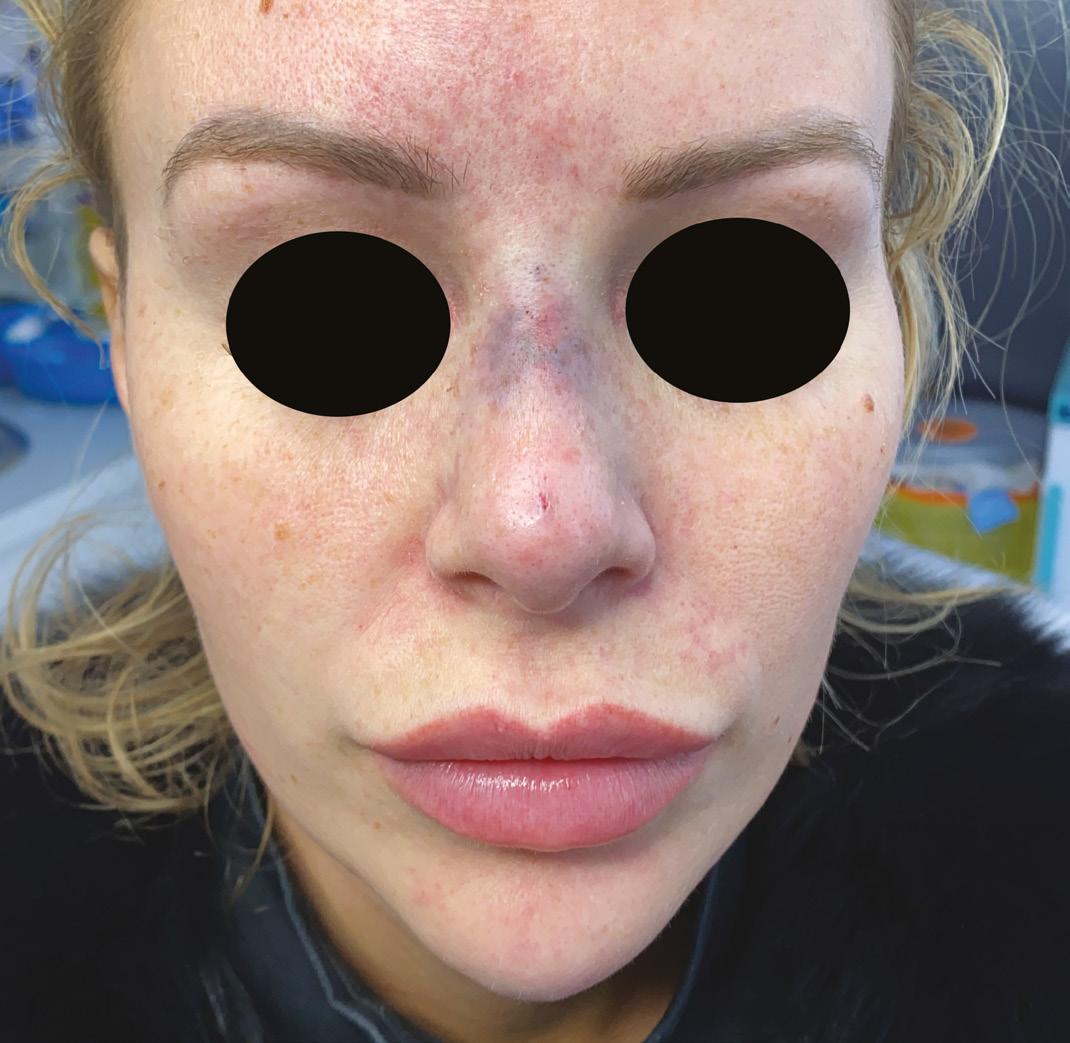
12 minute read
Marketing Summer Treatments
Sales director Graham Clarke discusses marketing strategies in the summer months and how businesses should promote different treatments
The summer season is almost upon us and whilst not all treatments are best suited to this time of year (due to concerns such as post-inflammatory hyperpigmentation) there are some amazing services we can and should be marketing to your treatment starved patients. A survey by Transform Hospital Group showed that people in the UK spend one third of their pre-holiday budget on beauty treatments,1 so it’s the perfect time to update your marketing strategies to reflect the season!
Advertisement
Following one of the longest winters and (enforced) hibernations we have seen for patients in our industry’s history, how do we market our services in these warmer, sunnier months and what are the best treatments to focus your marketing efforts on?
Changing your marketing strategy The first thing that you should consider when adapting your marketing strategy is whether your social media is summer fit and working for you as a strong channel.
Throughout my time working in the aesthetics specialty, I have always liked to change things up with strategic marketing seasonally. But before this, whenever I work directly with businesses in a coaching capacity, I always ask the question: does your social media audience match the number of clinic patients? If not, a perfect way to build on this is to encourage all patients to follow you in some way. This could be by using a teaser email sent out to your list of patients who have opted in, letting them know that you would love them to follow you on Instagram or Facebook, as they may be missing out on your summer promotions!
I also always recommend that clinics take time in the spring/summer to clean up or strategically change their angles and language for all available social media channels. So often in our industry we focus on the treatments, benefits, and results. Why not switch this up and ask your social followers what their main concerns are for the summer months? You can then respond with relevant posts, targeting these specific areas. You should always consider whether you are providing thoughtful content and speaking to the patient with real relevance to the season, if you’re truly engaging with patients, and whether you’re utilising these all-important business tools to educate and entice new patients.
When moving to a summer seasonal strategic marketing approach or changing things up with social media marketing, try having a look at the following: 1) Are your posts summer smart? I find posts with photos have high levels of engagement, particularly strong before and after shots. In late spring/early summer I recommend using before and after body shots. This is a key area of focus in the summer months and your patients, prospective or otherwise, will be calling to book after seeing what visible results can be achieved. I also find that in all campaigns it’s a good idea to ask relevant questions on social media to increase audience engagement. In summer for example, you might ask: ‘what do you use to protect your skin against the sun’s rays?’ and then explain more about its impact on ageing.
2) Are you optimising your supplier’s assets? In my experience, high performing posts generally feature product shots, so you should always speak to your supplier about whether they have readymade summer seasonal assets that you can use.
I find a good way to keep engagement is to feature a ‘product or treatment of the week’ specifically focusing on the benefit for the summer. If you do not have readymade assets, then perhaps when you are out on a long summer walk or a visit to the beach bring a skincare product or two and take a few pictures!
3) Can you create summer bundles?
If a patient books in for two or more treatments, could you retail a seasonal product, trial kit, travel set or sample pack? Creating a value proposition is sure to pique interest, particularly if the gift reflects the season or summer skin needs.
Your patients will travel this year, all be it planning summer trips or vacations in the
UK, so think about providing a kit that is easy for them to take away.
4) What time are your patients/audience most active? Does your audience spend a lot of time commuting to work? If so, maybe schedule posts just before they do so your messages pop up on their feed as they travel to and from work. If you have a lot of busy mums as patients, maybe think about scheduling when they have time in between school runs to check their feeds.
Remember this may well change in the summer months due to holidays with their children being at home so always check the analysis tools of your chosen social media platform which will show you when your followers are most active.
Medical aesthetics in a changing world
This promotional webinar series is organised and funded by Novo Nordisk Novo Nordisk products may be discussed during the webinars Prescribing information and adverse event reporting information are available on the website
Join us to hear how medical aesthetics is evolving and how you can integrate weight management both face to face and virtually, as well as gathering insights into Saxenda® (liraglutide 3mg) and weight management
The webinar will include a LIVE Q&A PANEL DISCUSSION where the expert speakers will be answering your questions

Tuesday 25 May 2021, 1pm and 7.30pm
Chair: Dr Tapan Patel MBBS MRCP Director, PHI Clinic Dr Awfa Paulina Medical Director, Clinica Medica Professor John New Consultant in Diabetes and Obesity
Saxenda® - Prescribing Information
Please refer to the Saxenda® summary of product characteristics for full information.
Saxenda®
Liraglutide injection 3 mg. Saxenda® 6 mg/mL solution for injection in a pre-filled pen. One pre-filled pen contains 18mg liraglutide in 3mL. Indication: Saxenda® is indicated as an adjunct to a reduced-calorie diet and increased physical activity for weight management in adult patients with an initial Body Mass Index (BMI) of ≥ 30 kg/m² (obesity) or ≥ 27 kg/m² to < 30 kg/m² (overweight) in the presence of at least one weight-related comorbidity such as dysglycaemia (pre-diabetes or type 2 diabetes mellitus), hypertension, dyslipidaemia or obstructive sleep apnoea. Posology and administration: Saxenda® is for once daily subcutaneous use only. Is administered once daily at any time, independent of meals. It is preferable that Saxenda® is injected around the same time of the day. Recommended starting dose is 0.6 mg once daily. Dose should be increased to 3.0 mg once daily in increments of 0.6 mg with at least one week intervals to improve gastro-intestinal (GI) tolerability. If escalation to the next dose step is not tolerated for two consecutive weeks, consider discontinuing treatment. Treatment with Saxenda® should be discontinued after 12 weeks on the 3.0 mg/day dose if patients have not lost at least 5% of their initial body weight. Daily doses higher than 3.0 mg are not recommended. No dose adjustment is required based on age but therapeutic experience in patients ≥75 years is limited and not recommended. No dose adjustment required for patients with mild or moderate renal impairment or mild or moderate hepatic impairment but it should be used with caution. Saxenda® is not recommended for use in patients with severe renal impairment including end-stage renal disease, or severe hepatic impairment or children and adolescents below 18 years. Contraindications: Hypersensitivity to the active substance or to any of the excipients. Special warnings and precautions for use: There is no clinical experience in patients with congestive heart failure New York Heart Association (NYHA) class IV and Saxenda® is not recommended for use in these patients. It is also not recommended in patients with eating disorders or treatment with medicinal products that may cause weight gain, as Saxenda® for weight management was not investigated in subjects with mild or moderate hepatic impairment; it should be used with caution in these patients. Use of Saxenda® is not recommended in patients with inflammatory bowel disease and diabetic gastroparesis since it is associated with transient GI adverse reactions including nausea, diarrhoea and vomiting. Acute pancreatitis has been observed with the use of GLP-1 receptor agonists, patients should be informed of the characteristic symptoms. If pancreatitis is suspected, Saxenda® should be discontinued. If acute pancreatitis is confirmed, Saxenda® should not be restarted. In weight management clinical trials, a higher rate of cholelithiasis and cholecystitis was observed in patients on Saxenda® than those on placebo, therefore patients should be informed of characteristic symptoms. Thyroid adverse events such as goitre have been reported in particular in patients with preexisting thyroid disease. Saxenda® should be used with caution in patients with thyroid disease. An increased risk in heart rate was observed in clinical trials. For patients who experience a clinically relevant sustained increase in resting heart rate, treatment with Saxenda® should be discontinued. There is a risk of dehydration in relation to GI side effects associated with GLP-1 receptor agonists. Precautions should be taken to avoid fluid depletion. Patients with type 2 diabetes mellitus receiving Saxenda® in combination with insulin and/or sulfonylurea may have an increased risk of hypoglycaemia. Fertility, pregnancy and lactation: Saxenda® should not be used during pregnancy. If a patient wishes to become pregnant, or pregnancy occurs, treatment with Saxenda® should be discontinued. It should not be used during breastfeeding. Undesirable effects: Very common(≥1/10); nausea, vomiting, diarrhoea, constipation. Common (≥1/100 to <1/10); hypoglycaemia, insomnia, dizziness, dysgeusia, dry mouth, dyspepsia, gastritis, gastro-oesophageal reflux disease, abdominal pain upper, flatulence, eructation, abdominal distension, cholelithiasis, injection site reactions, asthenia, fatigue, increased lipase, increased amylase. Uncommon (≥1/1,000 to <1/100); dehydration, tachycardia, pancreatitis, cholecystitis, urticaria, malaise, delayed gastric emptying Rare (≥1/10,000 to <1/1,000); anaphylactic reaction, acute renal failure, renal impairment. The Summary of Product Characteristics should be consulted for a full list of side effects.
MA numbers and Basic NHS Price:
5 x 3 ml pre-filled pens EU/1/15/992/003, £196.20. Legal category: POM.
Full prescribing information can be obtained from:
Novo Nordisk Limited, 3 City Place, Beehive Ring Road, Gatwick, West Sussex, RH6 0PA. Marketing Authorisation Holder: Novo Nordisk A/S, Novo Allé, DK-2880 Bagsværd, Denmark. Date last revised: December 2019
Saxenda® is a trademark owned by Novo Nordisk A/S.
Treatments to focus on In my experience, part of getting your marketing strategy summer ready is looking at what kinds of treatments you should be focusing your marketing efforts on. Below are some treatments that will likely be beneficial to your business to market during the warmer months. Of course, it’s always a good idea to actually ask your current patients what they want to hear about, as this can help you to understand what their biggest needs are at specific times of the year.
Skin treatments In the summer, patients want to ensure that their skin looks healthy and has a ‘summer glow.’ This is particularly important when there are days too hot for people to wear a full face of makeup and hide their skin concerns. In this regard, clinics can capitalise on various facials which can offer people deep hydration and cleansing, leaving their skin looking renewed. Clinics also have the option to create their own facials specifically designed for each season. This way, your patients know that what you’re offering can tackle their specific concerns during the summer period, for example sun protection, hydration and pigmentation.
Many of your patients will be used to getting chemical peels in the winter months, but high intensity deep chemical peels are not ideal for the summer as they can cause sun sensitivity and hyperpigmentation, as well as require a certain amount of downtime for the patient.2 However, this does not mean peels have to be avoided altogether. A superficial peel, such as an amino fruit acid/enzyme peel, can be a good alternative as it only targets the epidermis and is well tolerated by dry and sensitive skin.3 These light peels can help bring that much desired summer glow to the skin following the dark winter months, as well as prep the skin for more intensive peels when the time is right.
Body treatments Unlike traditional liposuction treatments that require some downtime and recovery, patients now have the option of nonsurgical body sculpting treatments such as cryolipolysis and muscle stimulation. Owing to the minimal recovery time, these are perfect for the summer months. Obviously, the patient will not see the results straight away but after as little as two to three treatments (depending on the technology used) the desired results can be achieved.
Smoother skin is also an absolute must in the summer period, particularly for those patients looking to improve the surface of their skin or who are concerned with the appearance of cellulite. Let your patients know that cellulite treatment devices, such as Endermologie or Thermage, can help improve their confidence and day-to-day interactions – they no longer need to fear wearing shorts in public or feel self-conscious to have their legs on show!
Homecare As well as advertising in-clinic treatments, we also must consider what at-home products will benefit our patients the most in the summer months. The obvious one is SPF and sun damage protection, although this should be a skincare staple in every patient’s routine every day of the year. Patients should always look to go for SPF 30 or above for sufficient protection.4 Prior to SPF application, the other topical formulation that should be recommended in the summer is a targeted vitamin C serum to assist with protection during the day, and keep the skin nourished. As mentioned above, these could be marketed together as a summer package for the ultimate skin protection.
Lips are an area that may get overlooked at this time but advising our patients to keep them protected and nourished is particularly important as they tend to dry out during the warmer months.
Start planning! When creating your marketing strategy for the summer months, you need to think strategicially about what your patients main concerns will be and communicate with them effectively. Once your patients are engaged and booked for their summer experiences, the will return for the more intensive treatments when the autumn inevitably rolls around again.
Graham Clarke has worked in the professional skincare and aesthetics specialty for more than 20 years, with global market experience in the business of the aesthetic skincare industry, from manufacturing, business coaching, marketing and distribution. He is currently the sales director responsible for the distribution and expansion of Image Skincare across the UK.
REFERENCES
1. Sian Ranscombe, 2017, Brits spend up to a third of their holiday budget on beauty, < https://www.harpersbazaar.com/uk/beauty/ skincare/news/a41454/brits-spend-up-to-a-third-of-holidaybudget-on-beauty/> 2. Costa M, et al., Review in peeling complications, 2017, Journal of Cosmetic Dermatology, <https://pubmed.ncbi.nlm.nih. gov/28349655/> 3. Sarkar S. et al, Chemical Peels: A Global Perspective, 2019 4. British Association of Dermatologists, Suncreen Fact Sheet, 2013, <https://www.bad.org.uk/skin-cancer/sunscreen-factsheet#spf-in-moisturisers>










